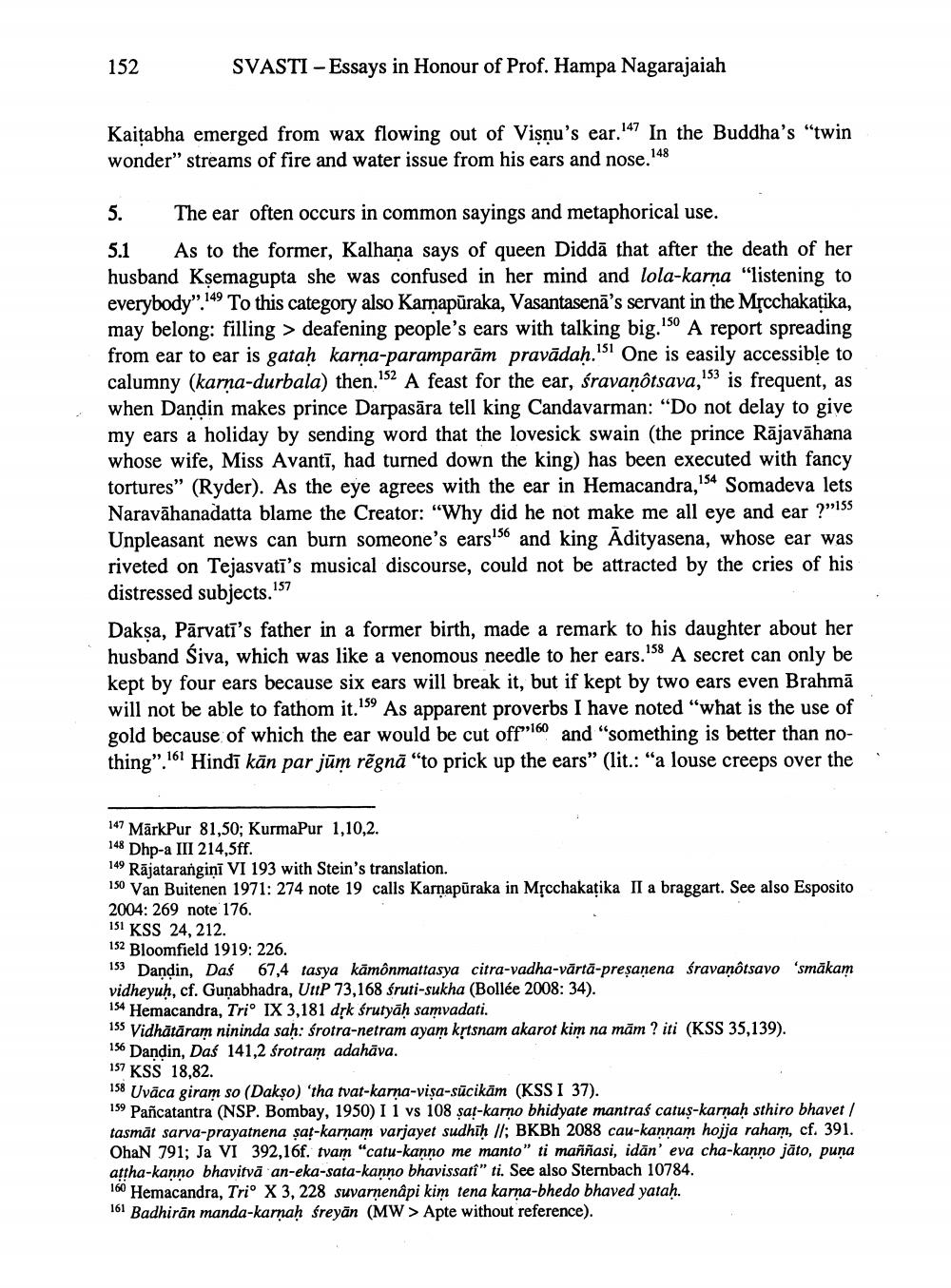________________
152
SVASTI - Essays in Honour of Prof. Hampa Nagarajaiah
Kaitabha emerged from wax flowing out of Visnu's ear.147 In the Buddha's "twin wonder" streams of fire and water issue from his ears and nose.148
5. The ear often occurs in common sayings and metaphorical use. 5.1 As to the former, Kalhana says of queen Diddā that after the death of her husband Ksemagupta she was confused in her mind and lola-karna "listening to everybody".149 To this category also Kamapūraka, Vasantasenā's servant in the Mșcchakatika, may belong: filling > deafening people's ears with talking big.150 A report spreading from ear to ear is gataḥ karņa-paramparām pravādah." One is easily accessible to calumny (karna-durbala) then."52 A feast for the ear, śravaņôtsava,"is frequent, as when Dandin makes prince Darpasāra tell king Candavarman: "Do not delay to give my ears a holiday by sending word that the lovesick swain (the prince Rājavāhana whose wife, Miss Avanti, had turned down the king) has been executed with fancy tortures” (Ryder). As the eye agrees with the ear in Hemacandra, 154 Somadeva lets Naravāhanadatta blame the Creator: "Why did he not make me all eye and ear ?"155 Unpleasant news can burn someone's ears!56 and king Adityasena, whose ear was riveted on Tejasvatī's musical discourse, could not be attracted by the cries of his distressed subjects.17 Daksa, Pārvati's father in a former birth, made a remark to his daughter about her husband Siva, which was like a venomous needle to her ears.18 A secret can only be kept by four ears because six ears will break it, but if kept by two ears even Brahmā will not be able to fathom it.159 As apparent proverbs I have noted "what is the use of gold because of which the ear would be cut off”60 and "something is better than nothing”. 161 Hindī kān par jūm rēgnā “to prick up the ears” (lit.: “a louse creeps over the
147 MārkPur 81,50; KurmaPur 1,10,2. 148 Dhp-a III 214,5ff. 149 Rājatarangini VI 193 with Stein's translation. 150 Van Buitenen 1971: 274 note 19 calls Karnapūraka in Mșcchakatika II a braggart. See also Esposito 2004: 269 note 176. 151 KSS 24, 212. 152 Bloomfield 1919: 226. 153 Dandin, Das 67,4 tasya kāmônmattasya citra-vadha-vārtā-preșanena śravanôtsavo 'smākam vidheyuḥ, cf. Gunabhadra, UttP 73,168 śruti-sukha (Bollée 2008: 34). 154 Hemacandra, Trio IX 3,181 drk Śrutyāḥ samvadati.
» Vidhātāram nininda sah: śrotra-netram ayam kştsnam akarot kim na mām ? iti (KSS 35,139). 156 Dandin, Daś 141,2 śrotram adahäva. 157 KSS 18,82. 158 Uvāca giram so (Dakso) 'tha tvat-karņa-vişa-sūcikām (KSS I 37). 159 Pañcatantra (NSP. Bombay, 1950) I 1 vs 108 sat-karno bhidyate mantraś catus-karnah sthiro bhavet/ tasmāt sarva-prayatnena sa-karņam varjayet sudhīḥ II; BKBh 2088 cau-kannam hojja raham, cf. 391. OhaN 791; Ja VI 392,16f. tvam "catu-kanno me manto" ti maññasi, idān' eva cha-kanno jāto, puna attha-kanno bhavitvā an-eka-sata-kanno bhavissati" ti. See also Sternbach 10784. 160 Hemacandra, Trio X 3,228 suvarnenäpi kim tena karna-bhedo bhaved yataḥ. 161 Badhiran manda-karmaḥ śreyān (MW > Apte without reference).




